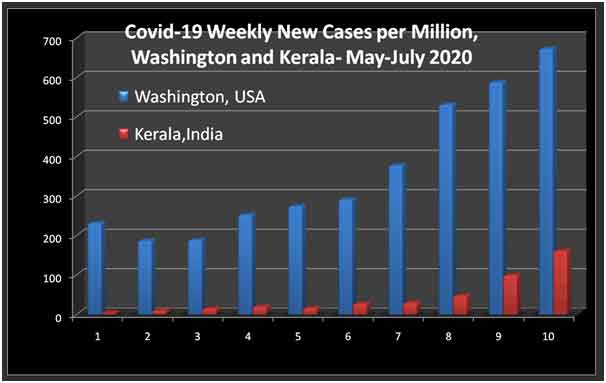There were 16.9 Million Covid-19 cases in the world as on 28 Jul 2020. This represents about 0.22% of the global population. Among the countries, the USA is on top with 4.5 M, closely followed by Brazil – 2.5 M and India 1.5 M. In short, these three countries with a total population of 1.9 billion have about half the total cases in the world.
The first case in the US was reported in the North-Western State of Washington on 21 Jan 2020. In India, the South-Western State of Kerala reported the first case on 30 Jan 2020. Both these index cases were infected in Wuhan. The total case load as on 28 July 2020 in Washington is 55,824 out of which 1,552 died. The total cases and deaths in Kerala are 20,894 and 67 respectively.
On March 11, Washington Governor Jay Inslee invoked emergency powers and banned “social, spiritual, and recreational gatherings” of over 250 people in hotspots. On the next day, he closed down all schools. The Chief Minister of Kerala Pinarayi Vijayan locked-down the State on 23 March, days before the national lockdown. In Washington, the Governor also issued a state-wide stay-at-home order on the same day.
In Kerala, the second and the third cases surfaced on 2nd and 3rd February; both were returnees from Wuhan. With no new case reported during next 35 days, the seed from Wuhan did not prosper in Kerala. From 08 March onwards, new cases were reported from among travellers from Europe and the Middle East.
On 9 March, the cumulative caseloads in Kerala and Washington were 9 and 279 respectively. The trajectories of the pandemic during the past 20 weeks since 9 Mar 2020 are given in the graph below:

The pandemic control operations in Kerala, carried out as per text book precision worked well till the middle of the period of analysis. On 4th May Kerala’s cumulative caseload was 499. Since then, from week No 10, we see the green column Kerala rising, more or less linearly. That is the time, the economy started opening up. During the last week (21 – 28 Jul 2020), weekly accretion of cases in Kerala surpassed Washington. Incidentally, during the past 10 weeks, the epidemic control team, have been working with the same level of commitment, sincerity and involvement since the day the first case was detected.
The so-called non-pharmacological interventions (NPI) did work at their best during the first 10 weeks in the graph. They have still been effective during the second half also as the R0 (the average number of people infected by one infectious individual) is less than 1 during this period also. For any NPI to work on a long term basis, people’s active involvement is a must. In Kerala, life has not returned to normal for majority of the people, though some sectors of economy are open. However, since the unlocking, the State has witnessed celebrations like marriage, funerals, belly dance, road shows and violent streets protests ordered by political parties – all violating the covid-19 protocols of social distance and face masks.
Though the battle has not been won, the war is not lost. Kerala has a population of 35 million as against 7.6 M in Washington. Weekly new cases of Covid-19 per million population in these two States for the past 10 weeks are given in graph below:

These are for 10 weeks. The attack rate (total confirmed cases divided by the total population) per million since the beginning of the pandemic in Washington is 7331 as against 600 in Kerala.
+++++++++++++++++++++++++++++++
VT Padmanabhan is a researcher in health effects of radiation. He has led epidemiological investigations among people exposed to high radiation in Kerala. He has also studied the occupational radiation hazards among workers of Indian Rare Earths, genetic effects of children exposed to MIC gases in Bhopal, health hazards to workers in a viscose rayon unit in Madhyapradesh and reduction of birth weight of babies near a beverage bottling plant in Kerala. He has visited several contaminated sites in Belarus and Japan and had extensive interactions with the survivors.His papers have been published in International Journal of Health Services, Journal of American Medical Association, International Perspectives in Public Health, the Lancet and Economic and Political Weekly.
SIGN UP FOR COUNTERCURRENTS DAILY NEWS LETTER















































